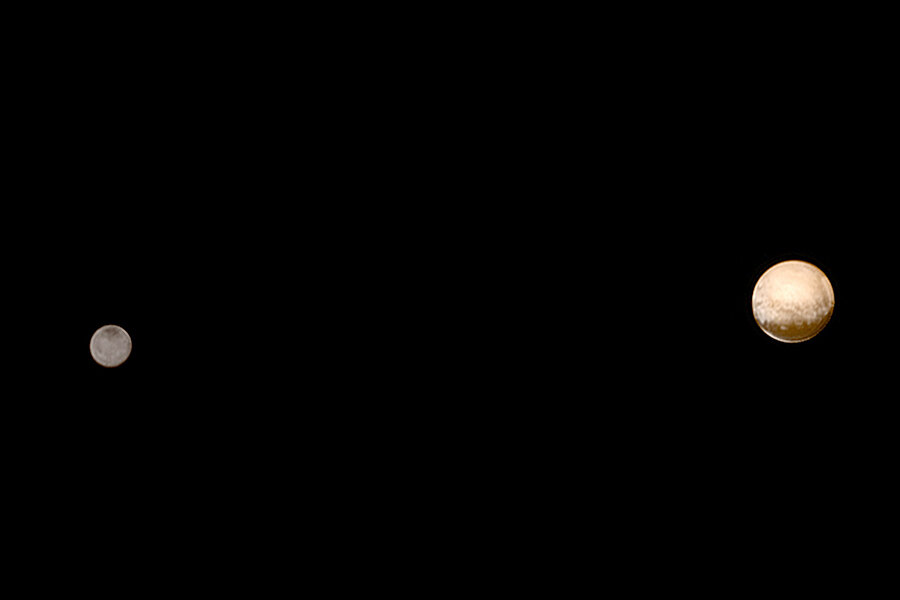Why does Pluto look as though 'someone painted it for a Star Trek episode?'
| Laurel, Md.
NASA's New Horizons mission to the Pluto-Charon system has yet to mark its finest hours – a historic flyby that makes its closest approach to the binary planet and its moons Tuesday morning.
But even as the spacecraft puts the wraps on its final approach, data New Horizons has delivered within the past 48 hours "is a gift for the ages," says Alan Stern, a planetary scientist at the Southwest Research Institute in Boulder, Colo., and the mission's principal investigator.
The craft's approach is revealing "tremendous diversity between the two planets in the system and their moons," he said. "We're already seeing complex and nuanced surfaces that tell us of history for these two bodies that is probably beyond our wildest dreams."
In short, "the Pluto system is enchanting in its strangeness and alien beauty," Dr. Stern said during a briefing Monday.
How alien?
It's as though "we're on the bridge of the Enterprise approaching some alien planet around Alpha Centauri 3 or whatever it is," said Paul Schenk, a planetary geologist at the Lunar and Planetary Institute in Houston and a member of the New Horizons science team. "It's like someone painted it for a 'Star Trek' episode."
Even seemingly mundane measurements, such as a new, more-accurate determination of Pluto's size – now pegged at 1,473 miles across, at the high end of estimates that have ranged from 1,429 miles to around 1,491 miles – carry import.
The new size, combined with long-established, precise measurements of Pluto's mass, yields a dwarf planet a bit less dense than previously estimated. That means its interior contains more ice, versus rock, than previously estimated. This change has implications – yet to be worked out – for the process that formed the binary-planet system as well as for the chemistry of the disk of dust, gas, and ice that encircled the sun and provided the building blocks for the planets ad their moons, Stern explained.
Bragging rights also come into play.
"The new measurement unambiguously settles the debate about the largest object in the Kuiper Belt," Stern said, referring to a region of the solar system extending more than 2 billion miles beyond Neptune. By some estimates, the region hosts trillions of comets as well as several hundred thousand objects larger than 60 miles across. It's also the region that gave birth to Pluto and the object that would collide with it to form Charon. Another Kuiper Belt inhabitant, Eris, had previously laid claim to the "largest" label at 1,445 miles across.
A larger Pluto also means that the lower layer of the atmosphere is shallower than previously thought, which will affect models that try to shed light on the atmosphere's structure and behavior.
Another early result involves nitrogen escaping from Pluto's tenuous atmosphere. New Horizons' instruments began to pick up the great escape five days ago, when the craft supposedly was too far away to see it, Stern said. It could mean that the nitrogen is fleeing the planet at a higher rate than models have suggested or that the mechanism responsible for triggering the loss is different than researchers have anticipated.
In addition, incoming data show that a hypothesized polar cap on Pluto is in fact an ice cap consisting of nitrogen and methane ices.
New Horizons also is revealing features on Pluto that are generating speculation, pending more detail from measurements taken at the closest approach.
For instance, images of Pluto released over the weekend show a surface that in many places hosted vast expanses of small, tightly packed dimple-like formations.
The features appear to be similar to those on Neptune's moon Triton, Dr. Schenk said. Triton – itself thought to be a Kuiper Belt object that Neptune captured – hosts a surface "that looks like a boiling pot of porridge, with cells of material popping up. They create a cellular pattern that looks like the skin of a cantaloupe."
There, researchers suspect that relatively buoyant rock or ice has risen from deeper in the crust to build the array of hills and depressions – similar in principle to salt domes that rise through surrounding rock to form low hills in southern Louisiana or southeastern Texas.
The science team hopes to get a closer look at some of these dimpled regions in images New Horizons takes during its closest approach Tuesday morning.
In addition, images so far show a relatively smooth surface over much of Pluto, suggesting that the surface could be relatively young, Schenk said.
Again, he cites Triton as a possible analog. The relative smoothness of much of Triton's surface suggests that it's less than 100 million years old. "On Triton, everything is very young," Schenk said.
It speaks to Triton as a captured Kuiper Belt object whose orbit around Neptune initially would have been elliptical, but over time became circular. The change in orbit would have heated Triton significantly, allowing fresh material to well up from depth and repave the surface, erasing any evidence of impact craters that would have accumulated over time.
On Pluto, "we're not seeing any large craters that would pop out and say: There's a big basin here," he says. "So we're beginning to think that maybe that it's a very young surface."
The source of internal heating required to provide material for repaving Pluto is unclear, Schenk acknowledges. Perhaps heat left over from the impact that formed Charon remained intense enough long enough to provide sources of fresh material for resurfacing Pluto.
"We still don't know," he says. "But we'll find that out."
[Correction: This article has been updated to correct the new measurements of Pluto's diameter.]






